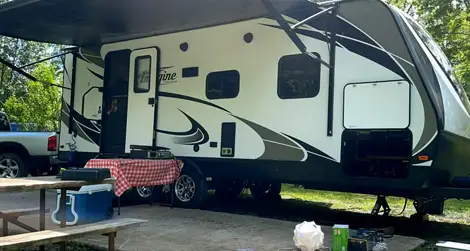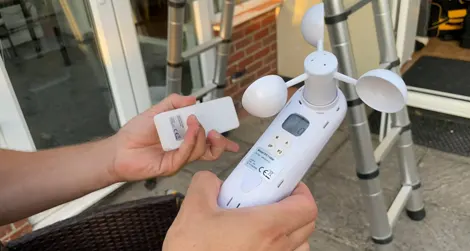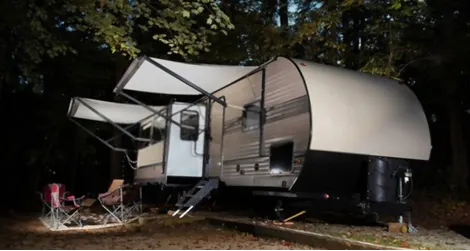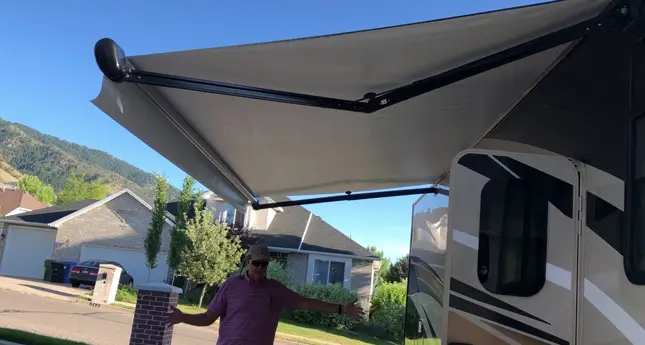Last Updated on April 20, 2023
In recent times, you have noticed that your awning has begun to retract on its own, even when there is no wind present or other obvious weather conditions. This can be distracting, especially if you are in the middle of using it.
Perhaps you are wondering why does my awning retract on its own? You should determine the cause of this issue in order to prevent it from happening again in the future.
An awning may retract on its own for a number of reasons. We will explore possible sources of this problem in order to find a satisfactory solution for it.
Why Does My Awning Retract on Its Own : Some Potential Causes

There are a few possible motives for the automatic retracting of an awning. Most awnings are designed to be retractable, which means they can be rolled up or down as needed.
But if your awning retracts on its own, there is a problem with the awning mechanism. The problem will continue to occur if you do not find the cause and the awning may suffer damage. Let’s take a look at some of the potential causes:
1. Incorrectly Installed Awning
Many times when an awning retracts on its own, it is because it was not installed correctly in the first place. The most common installation mistake is not properly attaching the awning fabric to the framework. If the fabric isn’t secured, wind can get underneath it and cause the awning to retract.
Another reason could be improperly sealing the awning arms to the side of the RV. Whenever wind may pass through the seal, it can catch under the awning and cause it to retract. Finally, if the awning is not level when installed, it may result in the awning retracting on one side due to gravity.
2. Loose Awning Arm
Awning arms are responsible for holding the fabric in place, so if they’re loose, the awning will start to collapse. The good news is that this is an easy problem to fix.
Simply tighten the screws that hold the arms in place, and your awning should be good as new. If you find your electric or manual awning problem, you must examine the awning arms. This will give you a chance to see if the screws are loose or not.
3. Faulty Motor
Some RV awnings are controlled by a motor. Such features are more common among larger RVs. This will make it easier to extend and retract the awning with the push of a button.
But if the motor is faulty, the awning may close spontaneously. The motorized awning can go bad for a number of reasons, including age, wear and tear, or damage from weather.
Whenever your motor seems to be malfunctioning, the first thing you’ll want to do is check for any obvious damage. If the awning motor looks damaged or dirty, it will need to be replaced. In the absence of visible damage, you will need to test the motorized awnings to ensure they are still functioning.
4. Wind Sensor

A number of retractable awnings are equipped with wind sensors. This is a small device that attaches to your retractable awning and automatically closes it when wind levels reach a certain threshold. This prevents damage as well as extends its lifespan.
However, if the wind sensor is faulty, it can cause your awning to retract even when there is no wind or when wind levels are low. If you suspect your wind sensor to be the cause of the problem, you can try calibrating it or replacing it altogether. As a result, your awning will only retract when it is supposed to.
5. Wiring Issues
Electric awnings are becoming increasingly popular, as they offer a number of advantages over traditional manual awnings. They are easy to operate and can be extended or retracted by pressing a button. As a result, they are ideal for those with limited mobility, as they do not require any strenuous efforts to set up or take down.
Nevertheless, an electric awning can be susceptible to wiring issues. If the wires become damaged or disconnected, it can trigger the awning to malfunction and retract automatically. This is often caused by weather damage, such as from wind, rain, or hail.
Whenever your awning is retracting due to electrical problems, you’ll need to have an electrician take a look at it to diagnose the problem. You can then ensure that your awning is safe for use and won’t damage your RV in the future.
6. Retract Button
Many people enjoy the convenience of automatic awnings, which open and close at the touch of a button. However, sometimes these awnings can seem to have a mind of their own, retracting when you least expect it. When your awning is equipped with a retract button, it’s possible that the button is simply stuck in the “on” position.
This can happen if the button becomes jammed or damaged. If this is the case, you will need to have the button replaced. Alternatively, you can try pressing and holding the button for a few seconds to see if that releases it. If the button does not appear to be the problem, there may be an issue with the awning itself.
7. Broken Pull Cord
Most awnings have a manual pull cord that you use to retract the awning. The pull cord is connected to a spring-loaded mechanism inside the awning roller tube. When the cord is pulled, the spring is released, and the awning is retracted. If the cord is broken, the awning will not be able to retract.
In most cases, the only way to fix a broken pull cord is to replace it with a new one. However, if the problem is with the spring-loaded mechanism, you may be able to repair it yourself.
Either way, it is best to consult with a professional before attempting any repairs. With their help, you can be certain that the awning will be retracted safely and securely.
8. Remote Control Problem
Having an awning that can be operated with remote control is very convenient. It allows you to open and close the awning without having to get up and do it yourself.
If the remote controller is not working properly, the awning may retract by itself without the means to control it. When the batteries are low or the signal is weak, the awning may not respond correctly to your commands.
As a result, it may start retracting even if you don’t want it to. To fix this problem, simply replace the batteries in the remote control or move closer to the awning so that the signal is stronger. Another possibility is that the remote may not be properly paired with the awning.
As such, you’ll need to refer to the product’s user manual for instructions on how to properly pair the two. If the problem continues, you may be required to exchange the remote control altogether.
Frequently Asked Questions:
There are many questions that people have regarding RV awnings. Here are some of the most frequently asked questions and their answers.
1. How Long Do RV Awnings Last?

The average lifespan of an RV awning is around 5 to 15 years. However, this can vary depending on the type of awning, the quality of the materials, and how well it is cared for.
Maintaining a clean and well-maintained awning can prolong its life. Additionally, if you live in an area with harsh weather conditions, it may be necessary to replace your awning more frequently.
2. How Do I Know If My Awning Is Damaged?
There are several signs that you can look for to determine if your awning is damaged. These include rips or tears in the fabric, loose or missing awning accessories, parts, and rust on the metal components.
If you notice any of these issues, it’s best to have your awning inspected by a professional. They can determine if the awning can be repaired or if it needs to be replaced.
3. What Can I Do to Prevent My Awning From Being Damaged?
Awnings can be protected from damage in several ways. First, you should clean it on a regular basis to remove dirt, pollen, and other debris. Second, you should inspect it regularly for any signs of wear and tear.
Finally, you should keep it retracted when bad weather is forecasted. By taking these precautions, it is possible to extend the lifespan of your awning.
4. How Do I Clean My Awning?
Cleaning your awning is fairly simple. First, you will need to remove any dirt or debris that has accumulated on the surface. You can do this by using a soft brush or a hose with a low-pressure setting.
Next, simply apply a mild soap or cleaner to the awning and scrub it gently. Finally, rinse the awning off with clean water and allow it to dry completely.
Conclusion
We hope that you have already found the answer to your question, “why does my awning retract on its own.” As you can see, there are several potential causes of this problem. However, in most cases, it can be resolved fairly easily.
If you take good care of your awning and inspect it regularly, you can help to prevent this problem from occurring. You can also consult the owner’s manual for troubleshooting tips specific to your awning. In the event that the problem persists, you may need to consult a professional for assistance.



